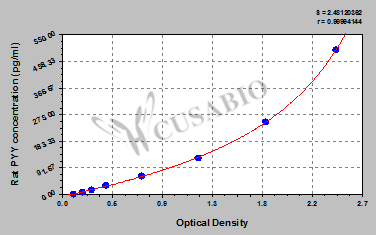This rat polypeptide YY (PYY) ELISA kit employs the quantitative sandwich enzyme immunoassay technique to measure the levels of rat PYY in different samples, including serum, plasma, or tissue homogenates. The enzyme-substrate chromogenic reaction is also used to amplify the signal and quantify the levels of the analyte through the intensity of the colored product. The color intensity positively correlates with the amount of PYY bound in the initial step.
PYY is an appetite-inhibiting gut hormone secreted from the L-cells of the gastrointestinal tract. Low levels of PYY are associated with higher BMI and obesity. Circulating PYY increases satiety and subsequently reduces food intake through gut-brain communication, and suppresses gastrointestinal motility and pancreatic hormone secretion. Circulating PYY levels increase during aerobic exercise. Additionally, PYY plays an integral part in maintaining energy homeostasis. PYY also plays an important role in the absorption of water and electrolytes.






